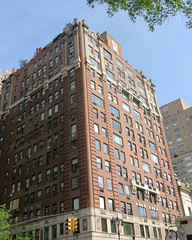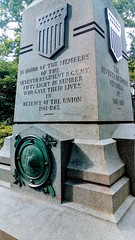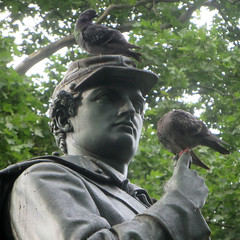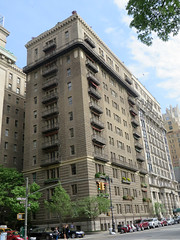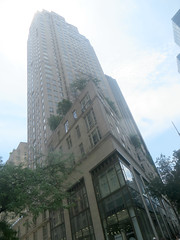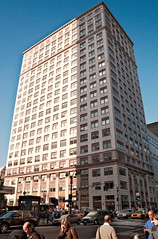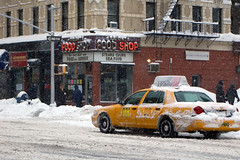West:
New-York Historical Society

170 (block): New York's first museum, it was founded
in 1804 because, in its founders' words, "Without the aid of
original records and authentic documents," they declared,
"history will be nothing more than a well-combined series of
ingenious conjectures and amusing fables."
Gouverneur Morris,
DeWitt Clinton,
Albert Gallatin and Hamilton Fish were among its early presidents.

Its current building, a Beaux Arts landmark, was opened in 1908,
designed by York & Sawyer (who did the Federal Reserve building)
and enlarged by Walker & Gillette in 1938. It houses a collection
that includes Audubon's watercolors for Birds of America,
one of the largest assemblages of Tiffany lamps, Washington's
Valley Forge camp bed and the desk where Clement Clarke Moore
probably didn't write "A Visit From Saint Nicholas."
|

160 (corner): Founded in 1838 as the fourth of seven
Unitarian societies in New York City, and the only one to survive
to the present day. Past congregants have included PT Barnum,
Horace Greeley and Lou Gehrig. Their current home
was built in 1898, designed by William Appleton Potter,
the architect of much of Princeton. The church features
an altar by Louis Comfort Tiffany, a bronze relief sculpture by
Augustus Saint-Gaudens, an RH Robertson mosaic and Clayton & Bell stained glass.

151 (corner):
The Kenilworth, a 13-floor co-op built
in 1908. The elegant building has been home to notables like
George M. Cohan, Basil Rathbone, Michael Douglas and Bill Moyers.
|
The San Remo

145-146 (block): Opened in 1930, the prestigious apartment
building was designed by Emery Roth with an 18-story based surmounted by two nine-floor towers;
the twin tower look was imitated by other CPW residences:
The Majestic, The Century and The Eldorado.
Jack Dempsey lived here in retirement for 30 years starting in 1928; Tony Randall
was a resident from the 1950s into the 1980s.
Songwriter Harold Arlen moved in in 1961 and died here on April 23, 1986.
Rita Hayworth also lived here from 1981 until her death on May 14, 1987.

Steve Jobs bought and renovated a tower apartment that he never lived in, instead selling it
to Bono. Bono later took another resident, less-famous rock star Billy Squier, to court over
his smoky fireplace.
Among the many other famous residents have been Diane Keaton,
Dustin Hoffman, Barry Manilow, Stephen Sondheim, Steven Spielberg, Donna Karan, Glenn Close, Don Hewitt, Aaron Spelling, Mary Tyler Moore, Hedy Lamarr,
Glenn Close, Steve Martin (with Victoria Tennant), Tiger Woods, Demi Moore and Bruce Willis, Elaine May, and Mick Jones.
The San Remo is named for a town on the Italian Riviera.
|
W <===
W 74TH ST
At this intersection on September 13, 1899, 68-year-old real estate broker
Henry H. Bliss was run down by an electric cab
driven by Arthur Smith—the nation's first auto accident death.
|
The Langham

135 (block): A 1907 residence with 13 floors, designed by Clinton & Russell;
the owners of the next-door Dakota tried unsuccessfully to prevent it from
being taller than their building. Acting teacher Lee Strasberg lived here from
1955 to 1982; Marilyn Monroe was a frequent visitor. Others at this
address have included Carly Simon
and Mia Farrow, whose apartment was featured in the 1986 film
Hannah and Her Sisters; the apartment earlier belonged
to Farrow's mother, Maureen O'Sullivan.
|

121 (block): This 1884 building, designed by Henry J. Hardenbergh in an eclectic German Renaissance style, has been called "the city's most legendary apartment building." At the time
the neighborhood was still quite rural, leading to speculation that the name
referred to how far north and west the address was.
The building has boasted numerous notable residents, most famously
John Lennon, who moved here in 1973 and was murdered here on December 8, 1980; his
widow, Yoko Ono, still lives there. Leonard Bernstein
lived here from 1974 until his death on October 14, 1990.
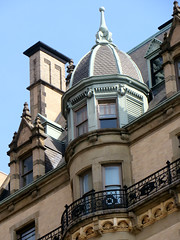
Other residents were Lauren Bacall (with her second husband Jason Robards), Judy Garland,
Rosemary Clooney (with Jose Ferrer), Boris Karloff, Judy Holliday, Carson McCullers, Roberta Flack,
Gilda Radner, Joe Namath, Jack Palance, Lillian Gish,
Rex Reed, Rudolph Nureyev, Rosie O'Donnell, John Madden and Connie Chung (with Maury Povich).
William Inge wrote Picnic, Bus Stop and Splendor in the Grass here.
The list of would-be buyers rejected by the Dakota's board
is likewise star-studded: Madonna, Cher, Billy Joel, Carly Simon,
Melanie Griffith and Antonio Banderas, Alex Rodriguez, Judd Apatow and Tea Leoni.
The building's exterior famously appears in
Rosemary's Baby, which calls the building "The Bramford." The
main character of Vanilla Sky also lives here, as does
Veronica Lodge before she moves to Riverdale. It features
in the novel Time and Again, as well as in Lee Child's
The Hard Way and The Babysitters' Club series.
|
|
|
East:
There used to be a good-sized body of water here called
the Ladies Pond, intended to provide an opportunity
for women to skate without being bothered by rakes and ruffians
(though a
depiction by Winslow Homer that appeared in Harper's
in 1860 suggests that co-ed skating was the norm there early on).
The pond followed the course of Saw Kill, Manhattan's longest
pre-colonial watercourse, named for the sawmill near the creek's mouth
near 75th Street on the East River. The Saw Kill's valley also provided
the outline for The Lake, the one where people rent rowboats.
The Ladies Pond was drained in 1930, and in its place is now
an artifical brook—fed by hidden pipes—that follows the Saw Kill's
course to empty into The Lake.
Azalea Walk

This footpath leads past masses of azaleas and rhodo- dendrons
that bloom in spring.
Strawberry Fields
 A two-and-a-half acre section of the
park that was reland- scaped and dedicated
as a memorial to John Lennon on October 9,
1985—which would have been the singer's 45th
birthday. Its centerpiece is a mosaic, a gift
from Naples, Italy, that bears the word "Imagine."
A two-and-a-half acre section of the
park that was reland- scaped and dedicated
as a memorial to John Lennon on October 9,
1985—which would have been the singer's 45th
birthday. Its centerpiece is a mosaic, a gift
from Naples, Italy, that bears the word "Imagine."
Women's Gate

When the entrances to Central Park were named in 1862, this one was
called the Women's Gate—perhaps because of its proximity to the
Ladies Pond? It leads to Riftstone Arch, a rustic bridge made from slabs
of Manhattan schist quarried from the park itself.
On this corner on November 27, 1997, the Cat in the Hat balloon
in the Macy's Thanksgiving Day Parade blew into a lamppost, injuring Kathleen
Caronna and putting her into a coma for nearly a month.
|
|


































































